The world is a fraught place, dear readers. And in such a world, it can be really, truly difficult to avoid seeing the world as an exclusively polarized place…as black/white, good/bad, right/wrong…and forget that very few things in human society are that simple.*
A few weeks back, there was a bit of a brouhaha in Library Land over a letter written by a children’s librarian in Cambridge, addressed to the First Lady of the United States regarding the donation of several children’s books to the school at which she worked. The letter is still posted on The Horn Book website. You can read it, if you so choose, and form whatever opinion you chose. The letter and its author have become the target for so much public debate, acrimony, and verbal bile that it doesn’t seem particularly useful for us to wade into the whys, wherefore, and whataboutisms.
However, I would like to bring up one point in the letter that many people have tended to overlook: that line that calls Dr. Seuss “a bit of a cliché, a tired and worn ambassador for children’s literature.”
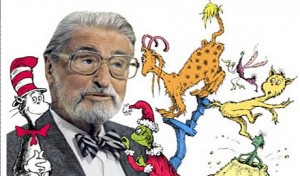
Now this is a subject that requires a lot more scrutiny. This is especially true in light of a recent announcement by the Dr. Seuss Museum in Springfield recently ordered a mural at The Amazing World of Dr. Seuss Museum to be removed because it contains an illustration of a Chinese man with chopsticks. This was in response to a letter written by author and illustrator Mo Willems and two other authors, Lisa Yee and Mike Curato stating that they would not be attending an event at the Museum, first, because of a mural on display there that depicts a scene from Dr. Seuss’ first book, And To Think That I Saw It On Mulberry Street, and secondly, because, when contacted, the administration of the museum “replied that it was the responsibility of visitors to contextualize the oversized painting of the ‘Chinaman’ for their younger wards, not theirs.”
The image depicts the reference in the story to “A Chinese man who eats with sticks“. The image itself is of a very stereotypical Chinese caricature, with a pointy hat, and slanted eyes.
So what are we to do with this information? What good librarian patrons do…get more information before making a judgement call.
Ted Geisel was absolutely a man of his time. He frequently reproduced cultural and racial stereotypes in his work without questioning their validity, their effect on others, or the harmful mentality that produced them–the Chinese man (or Chinaman in the original text) is just one example.
And, because it’s not a stereotype that is as widely discussed today, the image of the slant-eyed Chinaman with the pointed hat originated during the late 19th century. Chinese immigrants were associated with opium dens and often accused of ‘polluting’ British and American men (and women) who visited these dens. Around the turn of the century, it was quite normal to see highly stereotyped Chinese villains in books and films. They were portrayed as something other than human, and a threat to all “good” people.
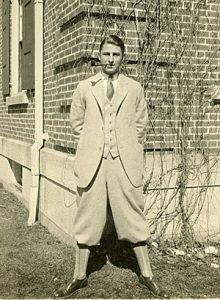 To provide a few examples: Philip Nel, who wrote the endlessly fascinating and extraordinarily thought-provoking book Was The Cat In The Hat Black?, points out that Geisel wrote and performed in a blackface minstrel show in high school, called “Chicopee Surprised”. When he was drawing the initial sketches for the Cat, in The Cat and the Hat, Nel observes, Geisel was “inspired by blackface performance, racist images in popular culture, and actual African Americans. Now, in 1920-1 when this show was performed, blackface was a very popular, highly visible form of caricature and entertainment. It was criticized as racist, demeaning, and offensive by some, but you don’t have to look any further than Al Jolson’s The Jazz Singer to see how well-known and generally unquestioned it was. (The photo to left is Geisel in 1925, when he was a student at Dartmouth College in Massachusetts, via Today In History).
To provide a few examples: Philip Nel, who wrote the endlessly fascinating and extraordinarily thought-provoking book Was The Cat In The Hat Black?, points out that Geisel wrote and performed in a blackface minstrel show in high school, called “Chicopee Surprised”. When he was drawing the initial sketches for the Cat, in The Cat and the Hat, Nel observes, Geisel was “inspired by blackface performance, racist images in popular culture, and actual African Americans. Now, in 1920-1 when this show was performed, blackface was a very popular, highly visible form of caricature and entertainment. It was criticized as racist, demeaning, and offensive by some, but you don’t have to look any further than Al Jolson’s The Jazz Singer to see how well-known and generally unquestioned it was. (The photo to left is Geisel in 1925, when he was a student at Dartmouth College in Massachusetts, via Today In History).
Following the bombing of Pearl Habor, Geisel, who drew a large number of political cartoons in the course of his career, drew a cartoon of a line of Japanese people, captioned the “Honorable 5th Column” waiting in a line to receive blocks of TNT, while one (highly racialized and stereotypes) figure looks eastward with a telescope “Waiting for a Signal from Home“. The cartoon supports Japanese interment camps, which were being established on the west coast, and in which American citizens of Japanese origin and heritage were treated with brutal inhumanity. This was not, by any means, the only racialized cartoon he drew to represent the Japanese during the Second World War.
None of these facts are pleasant or easy to discuss. It’s hard to accept that a person whose books you grew up cherishing was a human person with ugly, unquestioned prejudices.
But the story doesn’t stop here. Because Geisel was also a human being in the very best sense–he was able to grow, and to change. As Willems, Yee, and Curato wrote in their letter, “The career of Ted Geisel, writing as Dr. Seuss, is a story of growth, from accepting the baser racial stereotypes of the times in his early career, to challening those divisive impulses with work that delighted his readers and changed the time.”
Geisel began Horton Hears a Who in 1953, after a postwar visit to Japan, when he was researching a piece for Life magazine on the effects of the war and post-war efforts on Japanese children. With the help of Mitsugi Nakamura, dean of Doshisha University in Kyoto, Seuss went to schools all over Japan and asked kids to draw what they wanted to be when they grew up.
Having met Japanese people, and seen the effects of the war on everyday human beings there, he realized just what kind of harm caricatures like his earlier political cartoons had provoked. The book is dedicated to Nakamura, and the message, about embracing everyone’s humanity, regardless of whether they look or sound like, marks not only a huge moment in children’s literature, but also an enormously revelation for Geisel himself. The Whos are saved by one small Who, named Jo-Jo, makes his “Yopp!” heard–as Kelly Smith points out in this sensational blog post, “Dr. Seuss is stressing the power of a single voice making all the difference for a people and, with it, showing how he should have used his voice to protect the Japanese, rather than denigrate them.”
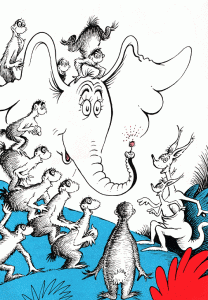
He more explicitly apologizes when he puts himself in his rightful place in history with the previously skeptical kangaroo, who says “from now on, you know what I’m planning to do?… From now on, I’m going to protect them with you” (page 58 of Horton Hears a Who)
Following Horton, he wrote The Sneetches, another book about how individuals are punished for the way they look, and the harm it does, not only to them, but to their whole society, as well. In 1973, he changed the text and the images in And To Think That I Saw It On Mulberry Street. He removed the “Chinaman” reference, changing the wording to “Chinese man”, and made the character’s face the same white color as the rest of the figures in the story. It’s not the everything. But it’s a huge sign of change.
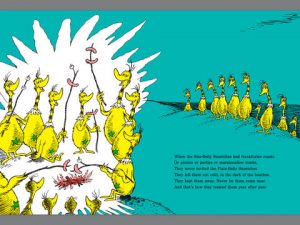
We need diverse books. We need to have children from all backgrounds and experiences to be able to see themselves in the stories we tell. Therefore, Dr. Seuss should by no means be the only books we read. However, neuroscientists have proven, through the marvels of science, that Dr. Seuss’ use of repetition, rhythm and rhyme help children in crucial ways to process the speech they hear, and fine-tune the connections between auditory and language networks in the brain.
But, maybe more importantly, Dr. Seuss’ own story teaches us a powerful lesson: people can change, and they can change for the better. Children, just like grown-ups, are faced everyday with people who are scared, who are angry, and who are resistant to change. We cannot protect them from that. But we can show them what positive growth and change looks like by talking to them about Dr. Seuss, and how he grew as a person, an author, and a spokesperson for humanity. This lesson is as important today–perhaps even more important–as it has ever been.
Portraying Seuss’ illustration of “the Chinaman” without talking about how it changed, and how he changed, really isn’t fair, either to Dr. Seuss or his readers. Portraying him as “tired” does enormous dis-service to the energy with which he combatted stereotypes and xenophobia in his later career. For that reason, it’s important not to forget Dr. Seuss’ inspiring contributions, even as we work to fill our shelves with a world of diverse books that tell even more powerful stories.
Because a person’s a person, no matter how small.
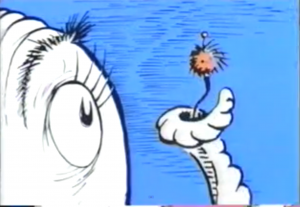
*Some things are that simple. Things like “be kind to others”, don’t drive if your motor skills are impaired”, “mosquitoes buzzing in your ears at night is awful”, or “raccoons are terrifying”.

Fantastic post! A personal favorite of mine that Seuss wrote is “The Butter Battle Book” about the harms and escalation of nuclear war. It’s not a widely known book of his, but it’s a potent story, again showing growth in his storytelling and the depth of his later themes.